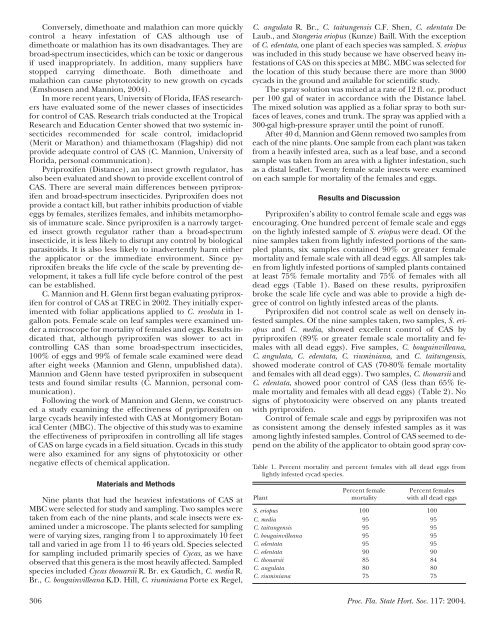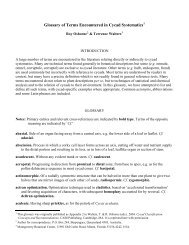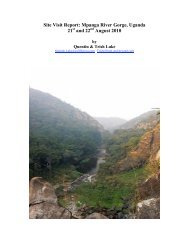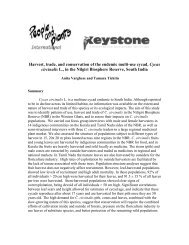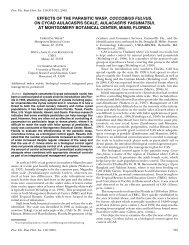Emshousen,C., C. Mannion & H. Glenn. 2004
Emshousen,C., C. Mannion & H. Glenn. 2004
Emshousen,C., C. Mannion & H. Glenn. 2004
Create successful ePaper yourself
Turn your PDF publications into a flip-book with our unique Google optimized e-Paper software.
Conversely, dimethoate and malathion can more quickly<br />
control a heavy infestation of CAS although use of<br />
dimethoate or malathion has its own disadvantages. They are<br />
broad-spectrum insecticides, which can be toxic or dangerous<br />
if used inappropriately. In addition, many suppliers have<br />
stopped carrying dimethoate. Both dimethoate and<br />
malathion can cause phytotoxicity to new growth on cycads<br />
(<strong>Emshousen</strong> and <strong>Mannion</strong>, <strong>2004</strong>).<br />
In more recent years, University of Florida, IFAS researchers<br />
have evaluated some of the newer classes of insecticides<br />
for control of CAS. Research trials conducted at the Tropical<br />
Research and Education Center showed that two systemic insecticides<br />
recommended for scale control, imidacloprid<br />
(Merit or Marathon) and thiamethoxam (Flagship) did not<br />
provide adequate control of CAS (C. <strong>Mannion</strong>, University of<br />
Florida, personal communication).<br />
Pyriproxifen (Distance), an insect growth regulator, has<br />
also been evaluated and shown to provide excellent control of<br />
CAS. There are several main differences between pyriproxifen<br />
and broad-spectrum insecticides. Pyriproxifen does not<br />
provide a contact kill, but rather inhibits production of viable<br />
eggs by females, sterilizes females, and inhibits metamorphosis<br />
of immature scale. Since pyriproxifen is a narrowly targeted<br />
insect growth regulator rather than a broad-spectrum<br />
insecticide, it is less likely to disrupt any control by biological<br />
parasitoids. It is also less likely to inadvertently harm either<br />
the applicator or the immediate environment. Since pyriproxifen<br />
breaks the life cycle of the scale by preventing development,<br />
it takes a full life cycle before control of the pest<br />
can be established.<br />
C. <strong>Mannion</strong> and H. <strong>Glenn</strong> first began evaluating pyriproxifen<br />
for control of CAS at TREC in 2002. They initially experimented<br />
with foliar applications applied to C. revoluta in 1gallon<br />
pots. Female scale on leaf samples were examined under<br />
a microscope for mortality of females and eggs. Results indicated<br />
that, although pyriproxifen was slower to act in<br />
controlling CAS than some broad-spectrum insecticides,<br />
100% of eggs and 99% of female scale examined were dead<br />
after eight weeks (<strong>Mannion</strong> and <strong>Glenn</strong>, unpublished data).<br />
<strong>Mannion</strong> and <strong>Glenn</strong> have tested pyriproxifen in subsequent<br />
tests and found similar results (C. <strong>Mannion</strong>, personal communication).<br />
Following the work of <strong>Mannion</strong> and <strong>Glenn</strong>, we constructed<br />
a study examining the effectiveness of pyriproxifen on<br />
large cycads heavily infested with CAS at Montgomery Botanical<br />
Center (MBC). The objective of this study was to examine<br />
the effectiveness of pyriproxifen in controlling all life stages<br />
of CAS on large cycads in a field situation. Cycads in this study<br />
were also examined for any signs of phytotoxicity or other<br />
negative effects of chemical application.<br />
306<br />
Materials and Methods<br />
Nine plants that had the heaviest infestations of CAS at<br />
MBC were selected for study and sampling. Two samples were<br />
taken from each of the nine plants, and scale insects were examined<br />
under a microscope. The plants selected for sampling<br />
were of varying sizes, ranging from 1 to approximately 10 feet<br />
tall and varied in age from 11 to 46 years old. Species selected<br />
for sampling included primarily species of Cycas, as we have<br />
observed that this genera is the most heavily affected. Sampled<br />
species included Cycas thouarsii R. Br. ex Gaudich, C. media R.<br />
Br., C. bougainvilleana K.D. Hill, C. riuminiana Porte ex Regel,<br />
C. angulata R. Br., C. taitungensis C.F. Shen, C. edentata De<br />
Laub., and Stangeria eriopus (Kunze) Baill. With the exception<br />
of C. edentata,<br />
one plant of each species was sampled. S. eriopus<br />
was included in this study because we have observed heavy infestations<br />
of CAS on this species at MBC. MBC was selected for<br />
the location of this study because there are more than 3000<br />
cycads in the ground and available for scientific study.<br />
The spray solution was mixed at a rate of 12 fl. oz. product<br />
per 100 gal of water in accordance with the Distance label.<br />
The mixed solution was applied as a foliar spray to both surfaces<br />
of leaves, cones and trunk. The spray was applied with a<br />
300-gal high-pressure sprayer until the point of runoff.<br />
After 40 d, <strong>Mannion</strong> and <strong>Glenn</strong> removed two samples from<br />
each of the nine plants. One sample from each plant was taken<br />
from a heavily infested area, such as a leaf base, and a second<br />
sample was taken from an area with a lighter infestation, such<br />
as a distal leaflet. Twenty female scale insects were examined<br />
on each sample for mortality of the females and eggs.<br />
Results and Discussion<br />
Pyriproxifen’s ability to control female scale and eggs was<br />
encouraging. One hundred percent of female scale and eggs<br />
on the lightly infested sample of S. eriopus were dead. Of the<br />
nine samples taken from lightly infested portions of the sampled<br />
plants, six samples contained 90% or greater female<br />
mortality and female scale with all dead eggs. All samples taken<br />
from lightly infested portions of sampled plants contained<br />
at least 75% female mortality and 75% of females with all<br />
dead eggs (Table 1). Based on these results, pyriproxifen<br />
broke the scale life cycle and was able to provide a high degree<br />
of control on lightly infested areas of the plants.<br />
Pyriproxifen did not control scale as well on densely infested<br />
samples. Of the nine samples taken, two samples, S. eriopus<br />
and C. media,<br />
showed excellent control of CAS by<br />
pyriproxifen (89% or greater female scale mortality and females<br />
with all dead eggs). Five samples, C. bougainvilleana,<br />
C. angulata,<br />
C. edentata,<br />
C. riuminiana,<br />
and C. taitungensis,<br />
showed moderate control of CAS (70-80% female mortality<br />
and females with all dead eggs). Two samples, C. thouarsii and<br />
C. edentata,<br />
showed poor control of CAS (less than 65% female<br />
mortality and females with all dead eggs) (Table 2). No<br />
signs of phytotoxicity were observed on any plants treated<br />
with pyriproxifen.<br />
Control of female scale and eggs by pyriproxifen was not<br />
as consistent among the densely infested samples as it was<br />
among lightly infested samples. Control of CAS seemed to depend<br />
on the ability of the applicator to obtain good spray cov-<br />
Table 1. Percent mortality and percent females with all dead eggs from<br />
lightly infested cycad species.<br />
Plant<br />
S. eriopus<br />
C. media<br />
C. taitungensis<br />
C. bougainvilleana<br />
C. edentata<br />
C. edentata<br />
C. thouarsii<br />
C. angulata<br />
C. riuminiana<br />
Percent female<br />
mortality<br />
Percent females<br />
with all dead eggs<br />
100 100<br />
95 95<br />
95 95<br />
95 95<br />
95 95<br />
90 90<br />
85 84<br />
80 80<br />
75 75<br />
Proc. Fla. State Hort. Soc. 117: <strong>2004</strong>.


